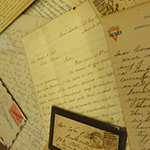 University Library
Sources of Inquiry
University Library
Sources of Inquiry
 University Library
Sources of Inquiry
University Library
Sources of Inquiry
Published first-person narratives can include memoirs, autobiographies, and other descriptions of events authors lived through. They were hugely popular in Europe and the United States in the 17th, 18th, and 19th centuries, when they played a major role in framing public discourse and influencing public opinion around topics like slavery, non-European peoples and cultures, international geopolitics, and world conflict.
Exploration and travel narratives, authored by men of European descent who explored "New World" frontiers, overwhelmingly presented non-European peoples as "other," emphasizing exploration of lands they "discovered" as sources of national glory, patriotism, wealth, and the dominion of European culture and power around the world. Examples in the case describe journeys to California, the Arctic, and the South Seas. Also often written about events in distant lands and territories, military narratives are usually authored by commanders, soldiers, and others who participated in military conflicts. They typically focus on the more thrilling aspects of specific battles, the ferocity and backwardness of the enemy, and combat.
American Indian captivity narratives emerged in North America in the 17th century. Popular until the close of the frontier in the 19th century, they were usually authored by former captives of Native Americans. These narratives frequently presented native peoples as uncivilized, alien, and undesirable. Their circulation amongst a wide American readership helped build public support for the removal of Native Americans to reservations among other social control measures. Slave narratives, the principal form of African-American literature in the 19th century, were also influential in shaping public opinion. Often edited or ghost authored by abolitionists on behalf of poorly-educated former slaves, their wide readership in the 18th and 19th centuries helped build public support for abolitionist movements on both sides of the Atlantic.
Case 10, Oral Histories, is located at the far left of the case that lines the wall near the Gohstand Reading Room.
1
Livermore, Mary A. My Story of the War: A Woman's Narrative of Four Years Personal Experience as a Nurse in the Union Army. Hartford, CT: A.D. Worthington and Co., 1889.E 621 L79
2
Anderson, Rufus. Memoir of Catharine Brown, a Christian Indian of the Cherokee Nation. Boston, MA: Samuel T. Armstrong, and Crocker and Brewster, 1825.E 90 B87 A4
3
Anderson, Æneas. A Narrative of the British Embassy to China, in the Years 1792, 1793, and 1794. Philadelphia: T. Dobson, 1795.DS 708 A54 1795b
4
Equiano, Olaudah. The Interesting Narrative of the Life of Olaudah Equiano, or Gustavus Vassa, the African. Dublin: W. Sleater, 1791.HT 869 E6 A3 1791
5
Northrup, Solomon. Twelve Years A Slave: Narrative of Solomon Northrup. Auburn, NY: Derby and Miller, 1853.E 444 N87
6
Vizetelly, Henry. Four Months Among the Gold-Finders in Alta California. London: D. Bogue, 1849.F 865 V54
7
Bryant, Edwin. What I Saw in California: Being the Journal of a Tour. New York: D. Appleton & Co., 1849.F 864 B81
8
Robinson, William Davis. Memoirs of the Mexican Revolution. Philadelphia: Lydia R. Bailey, 1820.F 1232 R66
9
Hall, Charles F. Narrative of the Second Arctic Expedition … and Residence Among the Eskimos During the Years 1864-'69. Washington, DC: Government Printing Office, 1879.G 665 1865 H2
10
Goodridge, Charles Medyett. Narrative of a Voyage to the South Seas and the Shipwreck of the Princess of Wales Cutter. Exeter: W.C. Featherstone, 1841.G 530 P95 G65 1841
